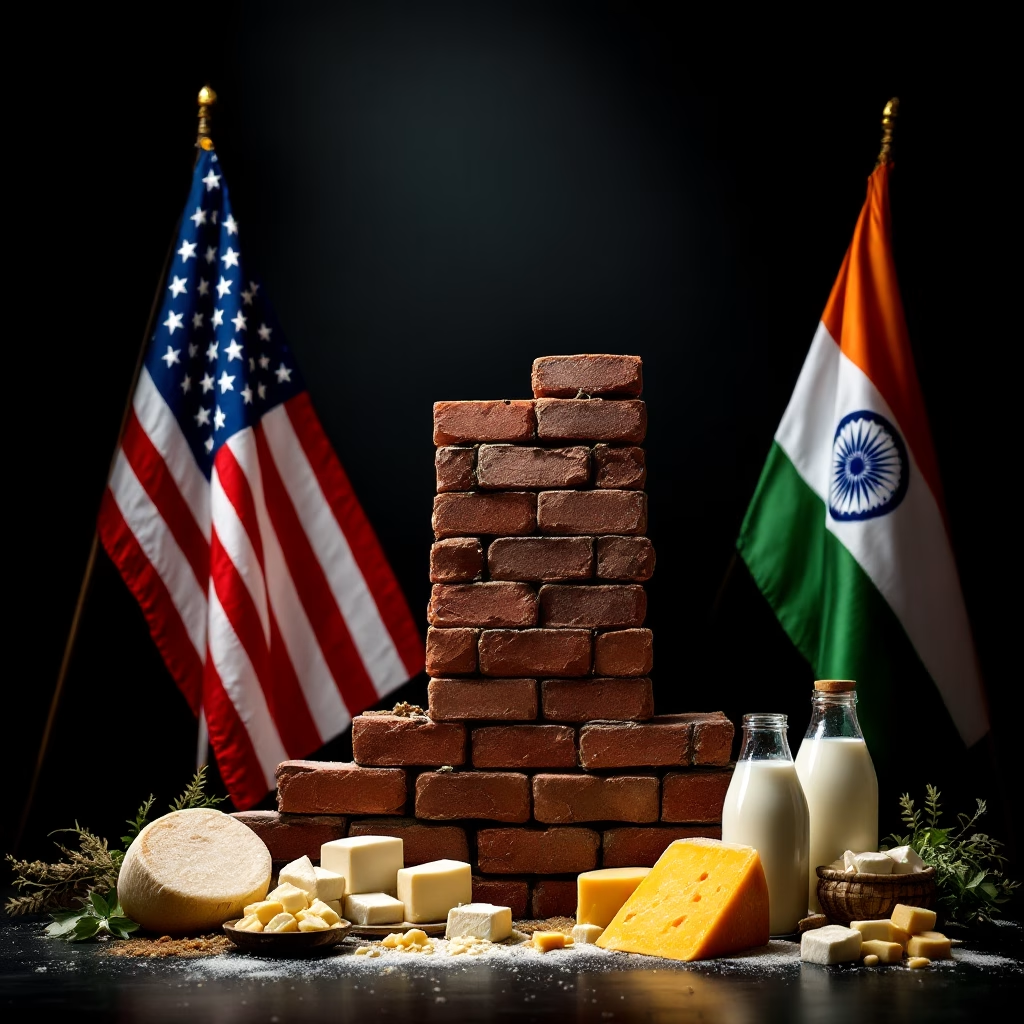Why US dairy can’t crack India: Sacred cows, 80M farmers & 60% tariffs block trade deals.

While Washington trade negotiators keep promising the moon, American dairy is getting exactly nowhere in cracking India’s market. And here’s the hard truth – it won’t happen anytime soon, no matter how many diplomatic niceties get exchanged this week in the latest round of talks.
The numbers don’t lie. India produces a staggering 230 million metric tonnes of milk annually – over 21% of global production. India represents the holy grail of untapped potential for US dairy exporters facing markets as saturated as a waterlogged pasture after three days of rain.
But make no mistake – this potential will remain as theoretical as a perfect lactation curve. Why? Because we’re not just up against tariffs. We’re up against an entire cultural, economic, and political system explicitly designed to keep us out.

The Rural Lifeline: More Essential Than Your Backup Generator
Let’s get real about what we’re asking India to do. Their dairy sector isn’t just another agricultural industry – it’s the economic backbone of rural society, contributing a whopping 4-5% to their GDP. That’s as significant as your milk check is to your farm’s bottom line.
While our industry has consolidated into fewer, larger operations, India’s milk comes from roughly 80 million farmers – most with just a few animals each. Imagine if every family in your county had a couple of cows in the backyard – that’s the scale we’re talking about.
Women make up about 70% of India’s dairy workforce. That’s higher than the percentage of heifers in most of our replacement programs! For millions of landless laborers and marginal farmers, dairy provides essential income that pays for education, healthcare, and daily needs.
Are we expecting India to sacrifice the livelihoods of 80 million farmers so that we can sell them some cheese? Would you willingly put your farm at risk for a foreign policy objective?
A Fortress of Protection That Makes Fort Knox Look Like a Petting Zoo
India’s defense of its dairy sector would make our farm lobbyists green with envy. Their average agricultural tariff is approximately 39% – dramatically higher than our 5%. For dairy specifically, applied tariffs range from 30% to 60%.
But tariffs are just the beginning, folks. A web of non-tariff barriers creates even more formidable obstacles. Most significant is India’s requirement that imported dairy products be derived from animals that have “never been fed” materials containing internal organs, blood meal, or tissues from ruminant origins.
This restriction directly conflicts with standard feeding practices in the US dairy industry. It’s like telling us we can’t use silage or TMRs – it goes against everything we know about efficient dairy production.
And here’s what the trade negotiators won’t tell you: this isn’t about science or food safety. It’s about religion and culture. The cow holds sacred status in Hinduism. This isn’t going to change because some Washington bureaucrat thinks it should.
The Narrow Path: Where US Dairy Has Found Limited Success
Despite these barriers, we’ve succeeded in specific niche segments – primarily ingredients rather than consumer products. The United States is India’s second-largest whey protein supplier, commanding a 21% market share, and the third-largest lactose supplier, with a 13% share.
Demand for these specialty ingredients is robust and growing. According to USDA projections, Indian imports of whey protein are forecast to increase by 20% in 2025, with lactose imports expected to rise by 21%.
But let’s not kid ourselves – this isn’t a breakthrough. It’s a concession India makes because they need these specific ingredients. They’re allowing imports of whey and lactose because they address specific industrial needs without directly competing with domestic fluid milk and butter production.
The Hard Truth: Investment, Not Exports, Is the Only Way Forward
Here’s what the US dairy industry needs to hear, even if it’s uncomfortable: we need to stop expecting trade negotiations to open India’s market and start thinking like the Europeans.
While our government pushes for market access through trade negotiations, European dairy companies have pursued a different strategy – establishing a presence in India through acquisitions and joint ventures rather than exports.
France’s Lactalis Group has built a substantial foothold in the Indian market by owning Indian dairy brands such as Tirumala, Anik, and Prabhat. Similarly, the Bel Group has established a joint venture with Britannia Industries to manufacture and sell cheese products within India.
These approaches bypass many trade barriers by producing locally rather than importing. They also align better with India’s economic priorities by creating local manufacturing and potentially supporting domestic milk producers rather than competing with them.
So why aren’t more US dairy companies pursuing this strategy? Are we too stubborn to adapt? Are we too reliant on government trade negotiations to solve our problems? The Europeans eat our lunch while we wait for Washington to deliver a miracle that isn’t coming.
What This Means for Your Operation
Let’s get practical about what this means for your farm:
- Export market diversification is crucial. With India effectively closed, US exporters will continue focusing on East Asia, Mexico, and the Middle East. Is your co-op or processor positioned well in these markets?
- Value-added is the future. The limited success in exporting whey and lactose to India suggests US producers might further specialize in high-value dairy ingredients for global markets. Are you supporting processors who are investing in these capabilities?
- Investment over export. More US dairy companies must follow the European model, pursuing joint ventures or acquisitions in India rather than direct exports. Is your industry organization pushing for this approach?
- The domestic focus remains essential. Maintaining strong domestic demand becomes even more critical with global market access challenges. Are you supporting domestic promotion efforts?
The Bottom Line: Time For a Reality Check
For US dairy exporters eyeing India’s massive market, the hard truth is that significant access remains as remote as finding a perfect cow. The path is obstructed by deeply rooted barriers that transcend typical trade policy.
It’s time we stopped letting politicians and trade negotiators sell us false hope about the Indian market. The combination of economic importance, cultural factors, and political realities makes India’s dairy sector exceptionally resistant to foreign competition.
What should we be doing instead?
- Focus on markets where we can compete
- Invest in product innovation for ingredients that can penetrate restricted markets
- Push our major dairy companies to pursue joint ventures and acquisitions in India
- Demand that our trade representatives be honest about what’s achievable
The path to India’s dairy market appears to run through partnership rather than pure trade liberalization – at least for the foreseeable future. Are we willing to adapt our approach, or will we keep banging our heads against a wall that isn’t coming down?
The choice is yours. But remember – while we’re waiting for a miracle in India, our global competitors are moving on to more practical strategies. Isn’t it time we did the same?
Key Takeaways
- Economic fortress: Dairy supports 80M Indian farmers (70% women) and contributes 4-5% to GDP.
- Tariff wall: 30-60% import duties + flexible WTO-bound rates up to 300% protect domestic markets.
- Cultural red line: Sacred cow status fuels non-negotiable bans on US feeding practices.
- Niche exceptions: Whey/lactose imports grow 20% annually but don’t signal broader access.
- Strategic shift: Europe’s local investment model outperforms US export-focused approaches.
Executive Summary
Despite ongoing trade negotiations, the US dairy industry faces insurmountable barriers to entering India’s protected market. India’s dairy sector forms 4-5% of its GDP and supports 80 million small farmers, making it politically untouchable. The country maintains 30-60% tariffs on dairy imports and culturally rooted non-tariff barriers like bans on cattle feed practices common in US farming. While niche ingredients like whey see limited growth, mainstream products face rejection due to sacred cow protections and domestic self-sufficiency. Experts argue that US firms should follow Europe’s model of local partnerships rather than push for market access through failed trade talks.
 Join the Revolution!
Join the Revolution!
Join over 30,000 successful dairy professionals who rely on Bullvine Daily for their competitive edge. Delivered directly to your inbox each week, our exclusive industry insights help you make smarter decisions while saving precious hours every week. Never miss critical updates on milk production trends, breakthrough technologies, and profit-boosting strategies that top producers are already implementing. Subscribe now to transform your dairy operation’s efficiency and profitability—your future success is just one click away.







 Join the Revolution!
Join the Revolution!








